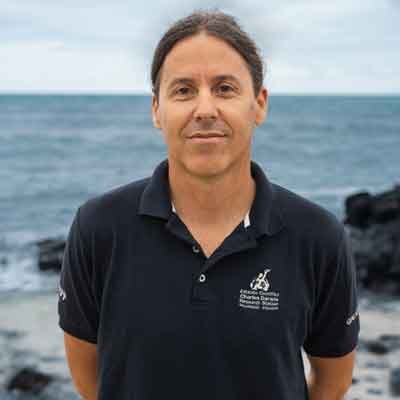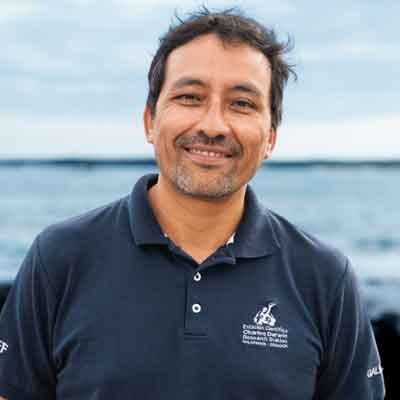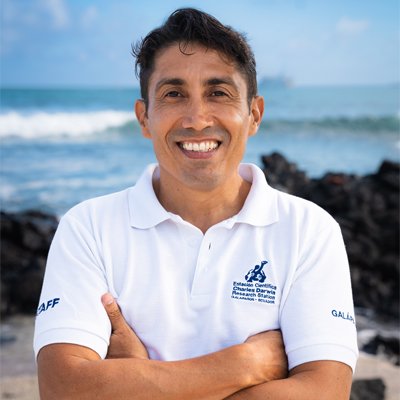Mangroves in Galapagos provide important habitat for endemic and threatened species, offer essential ecosystem services like carbon sequestration, and support the well-being of local communities through tourism and fisheries. Despite their importance and pristine condition, these mangrove ecosystems and their potential for climate mitigation remain understudied.
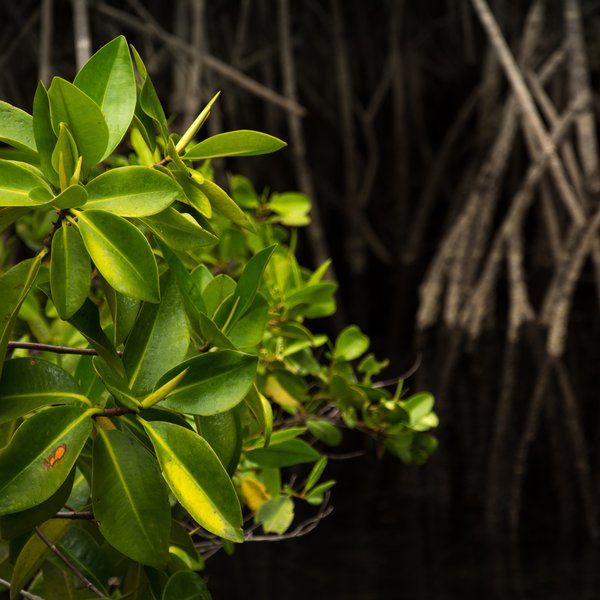
Our team
Nicolás Moity
Senior Researcher in Marine Sciences & Geospatial expert
Jorge Ramírez
Co-Principal Investigator - Sustainable Fisheries
Gustavo Jiménez Uzcátegui
Principal Investigator - Marine Bird Conservation
Collaborators
Amanda Bates
Derrick Vaughn
Easton White
Edgardo Londoño-Cruz
Enirque Montes
Gonzalo Bravo
Gregorio Bigatti
Ilka (Candy) Feller
Frank Muller-Karger
Luigimaria Vittorio Borruso
Ramesh Wilson
Collaborating institutions
Free University of Bozen-Bolzano
Galapagos National Park Directorate
GEO MBON – Marine Biodiversity Observation Network
GEO BON - Ecosystem Services
Global Mangrove Alliance
IUCN Global Red List of Ecosystems
Leibniz Centre for Tropical Marine Research (ZMT)
Mangroves International Coordination Action – MICA
Smithsonian Environmental Research Center (SERC)
University of Oxford
Yale University
Donors
Anonymous donor
Resources
Studying mangroves in the Galapagos
Documenting mangrove forests in the Galapagos Islands, and their cover change through time
A cost-effective tool for mapping mangroves
The value of Galapagos’ mangroves
Marine Biodiversity Observation Network
Recent papers - Google Scholar
THE CHALLENGE
Unlike on the Ecuadorian mainland, where mangrove forests have been severely impacted by deforestation for shrimp aquaculture, mangroves in Galapagos are nearly pristine, with no shrimp or fish farming allowed. As a result, they provide a living laboratory where we can study natural processes with minimal human impact, and isolate and identify the effects of climate change.
In the absence of rivers and estuaries, mangroves in Galapagos grow in an arid coastal environment and on bare, geologically young lava rock instead of fine sediment. This means that mangroves in Galapagos are outside of their typical physiological range, with potentially unique evolutionary adaptations. Due to relatively frequent volcanic eruptions, mangrove colonization of bare lava is constantly taking place, making it an ideal setting to study how mangroves become a foundation species over time, transforming an extremely harsh colonization environment into a haven for biodiversity.
To date, mangroves remain largely understudied in Galapagos and much remains to be understood about their potentially different ecology and unique role in providing vital ecosystem services.
WHY IT MATTERS
Like elsewhere in the world, mangroves are a key ecosystem along the coastlines of the archipelago, providing the islands with numerous vital ecosystem services.
A critical habitat for endemic & threatened species
Mangroves provide shelter, feeding and nursery grounds for at least 300 animal species, of which more than 60 are endangered or endemic, such as sharks, rays and turtles, including the iconic and critically endangered hammerhead shark and Mangrove finch. They are also used by sea lions and marine iguanas for roosting, and harbor small pelagic fish that are eaten by emblematic bird species, such as the endangered Galapagos penguin, flightless cormorants and boobies. Mangroves are also critical for decomposers and other fishery species, such as sea cucumbers and lobsters.

Carbon sequestration
Mangroves are known to be the most efficient carbon capture and storage system in the world, storing more carbon per unit area than any other ecosystem. For this reason, their importance in mitigating climate change is outstanding, and they are considered a pillar of nature-based solutions in the fight against climate change.
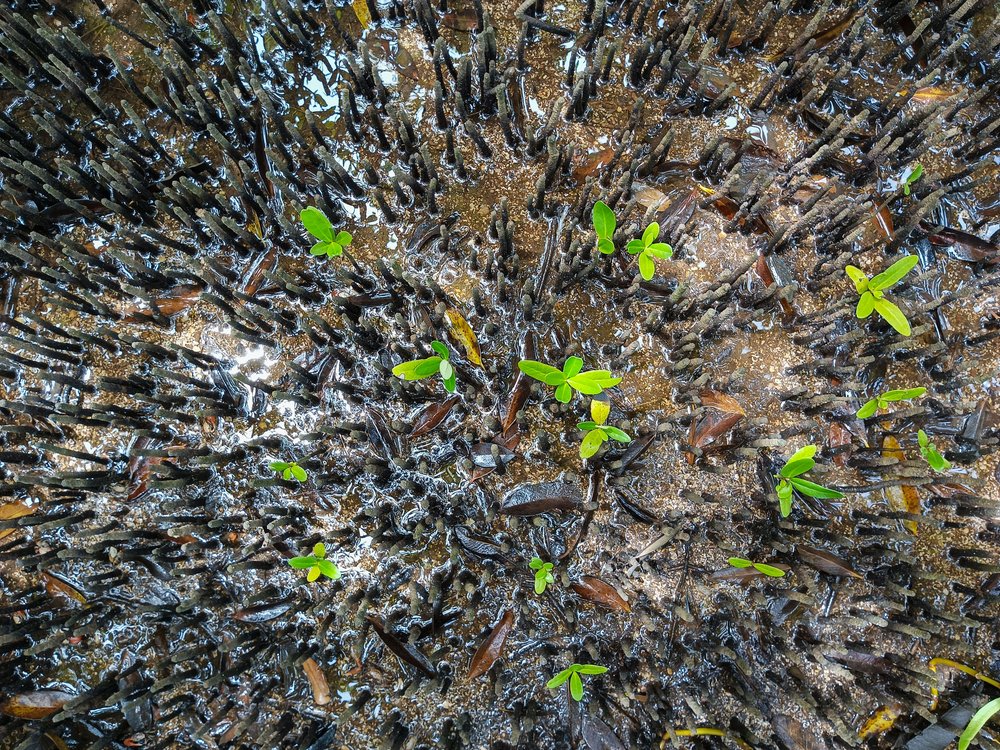
Supporting the well-being of local livelihoods
Mangroves are a critical part of the life cycle of seafood that supports Galapagos artisanal fisheries (snapper, lobster), including the endangered Galapagos sailfin grouper. They also contribute to the local tourism industry, given their important role as nursery grounds for iconic species, such as sharks, which attract visitors from all over the world.
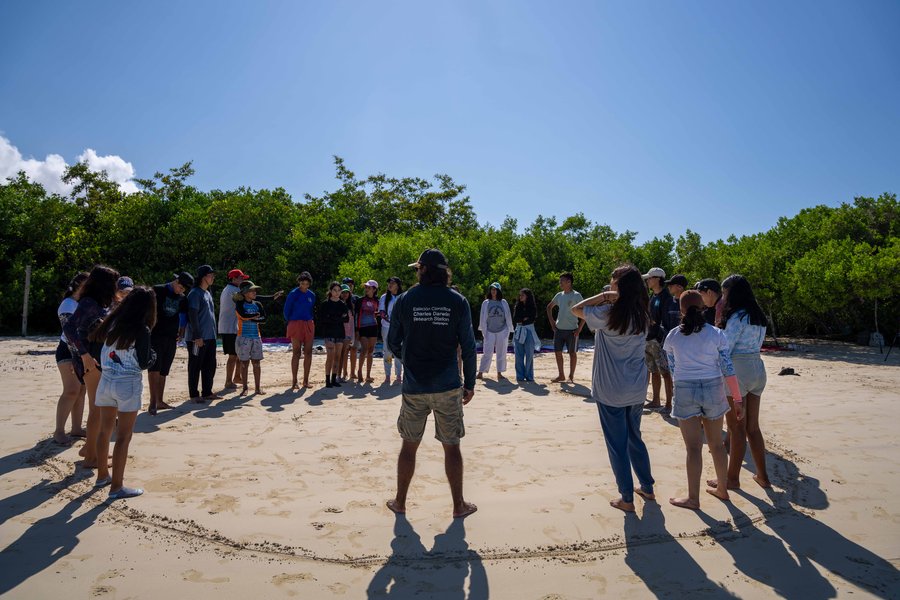
WHAT WE DO
Our program seeks to study mangrove ecology and assess the impacts of climate change on the ecosystem and its ability to provide key ecosystem services in the Galapagos. Our approach takes into consideration the entire ecosystem and its interconnected components:
Understanding the ecology of mangroves
We study the ecology of mangrove forests and their role as key habitats for numerous species. We are studying landscape-level mangrove distribution and change over time through the use of satellite and drone imagery, while fine-scale studies are done at the forest level. We assess species composition, size, and growth of mangrove forests, including their density, amount of plant material (biomass), number and size of dead trees, and the process of new plant recruitment by means of permanent monitoring plots. We study mangrove production, that is, the amount of leaves, fruits, flowers and twigs that mangroves produce per unit area, and the proportion that is decomposed by microorganisms and invertebrates, and transferred to the food chain and other marine ecosystems. We are also pioneering studies on the microbial community in mangrove soils.
Studying mangrove connectivity and genetic diversity
We study mangrove connectivity through genetic studies and mangrove dispersal in an effort to understand how mangrove populations are connected among islands, and with the continent. Genetic studies can also tell us if mangroves in Galapagos have evolved differently from those found on the mainland or elsewhere in the world.
Investigating the role of mangroves for key marine species
Many important marine species use mangroves for food, shelter and reproduction, including ten species of sharks and rays. We are studying the marine species that use mangroves, their connection to other marine ecosystems, and how their use of this ecosystem is changing with increasing climate variability and human use.
Updating the IUCN Red List of Threatened Ecosystems
We are contributing to the first IUCN Red List of Threatened Ecosystems assessment of mangrove forests, an important first step in putting Galapagos mangroves on the global map. This list assesses the potential of a given ecosystem to collapse through a standardized, comprehensive assessment of its health status and loss of critical habitat.
Studying carbon sequestration and storage
We are studying the mangroves' blue carbon capacity; that is, their capacity to sequester and store carbon, which is crucial for climate change mitigation efforts. We are also studying the rate at which mangroves sequester carbon in soils, and how this has changed since they first colonized Galapagos.
Assessing the impact of climate change
We study the impact of climate change, in particular the effects of El Niño and La Niña phenomena on mangrove ecology and the biodiversity found in them, the growth rate of mangrove forests, and other aspects, such as reproduction and germination. We are also looking at the potential impacts of climate change and variability on carbon sequestration, their function as habitat for marine species and their ecosystem services.
Studying landlocked mangroves
Galapagos is home to landlocked mangroves, meaning that these mangroves have no physical access to the sea, which is highly unusual. Such landlocked forests are now home to the critically endangered Mangrove Finch. We are studying these landlocked mangrove forests to learn more about how they survive and thrive, and the unique conditions that allow them to exist in the first place.
Environmental education
We work closely with CDF’s education and community outreach program to develop educational activities with the local community on the importance of mangroves in the Galapagos Islands through experiential learning using mangroves as a classroom.
Program Objectives
- Measure how much carbon mangroves store across different areas of the archipelago.
- Study how mangroves affect other marine life: how much they produce, break down, and grow.
- Understand how vital mangroves are for animals like sharks, turtles, and fish.
- Predict how climate change will impact carbon storage, mangrove structure, and fish populations.
- Investigate how people, mangroves, and wildlife interact.
- Assess which mangrove areas provide higher levels of ecosystem services to aid in the prioritization of conservation efforts.
- Raise awareness to the importance of mangroves among the local community.
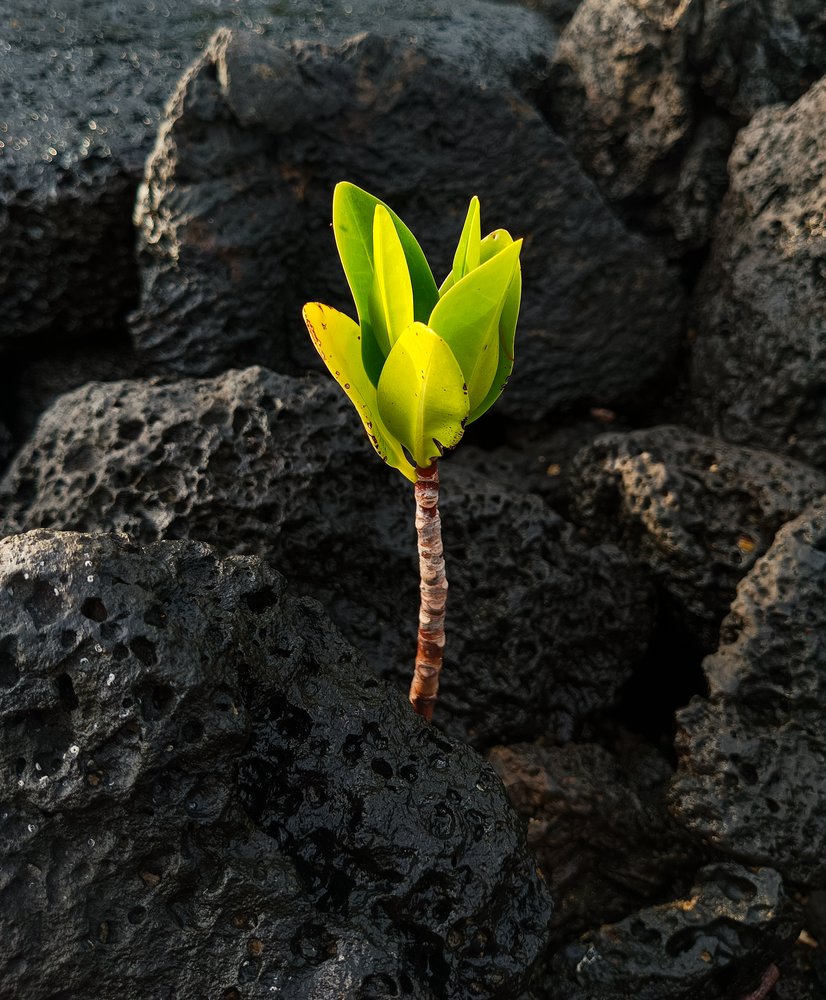
Our impact
Mapping mangrove forests in Galapagos
We have updated the distribution of mangroves in Galapagos using satellite imagery; we know how much mangrove there is and where it is, which represents a first step in understanding any ecosystem. We also made a first assessment of the change in mangrove cover over 10 years, showing that it is one of the few places on the planet where mangrove expansion has occurred without human intervention.
Estimating mangrove value
We have conducted an initial assessment of the economic value of their key ecosystem services, which amounts to more than US$70 million, highlighting their outstanding economic conservation value.
Promising early carbon sequestration results
Early pilot studies conducted by our scientists indicate that mangroves in Galapagos have the potential to store 1.8 million tons of blue carbon, which would be roughly equivalent to taking 1.4 million cars off the road for an entire year! More studies to assess Galapagos mangrove’s precise blue carbon capacity are currently underway.
Tracking El Niño in mangrove ecosystems
More than 30 temperature loggers have been strategically placed throughout the Galapagos Marine Reserve to track El Niño-induced temperature fluctuations and their impact on biodiversity and mangrove forest change.
WHY YOU SHOULD SUPPORT US
By supporting our mangrove conservation program, you are helping us understand and conserve a critically understudied ecosystem, vital for climate change mitigation, for endemic and threatened fauna and flora, as well as local communities.
Here are some specific examples of how your donation could be used:
- Support studies that help us estimate the carbon storage capacity of Galapagos mangroves.
- Help us roll out more experiential activities with local kids to raise awareness of the importance of mangrove forests.
- Fund field trips to remote landlocked mangrove forests on Isabela Island during the Mangrove Finch nesting season to study this unique habitat.
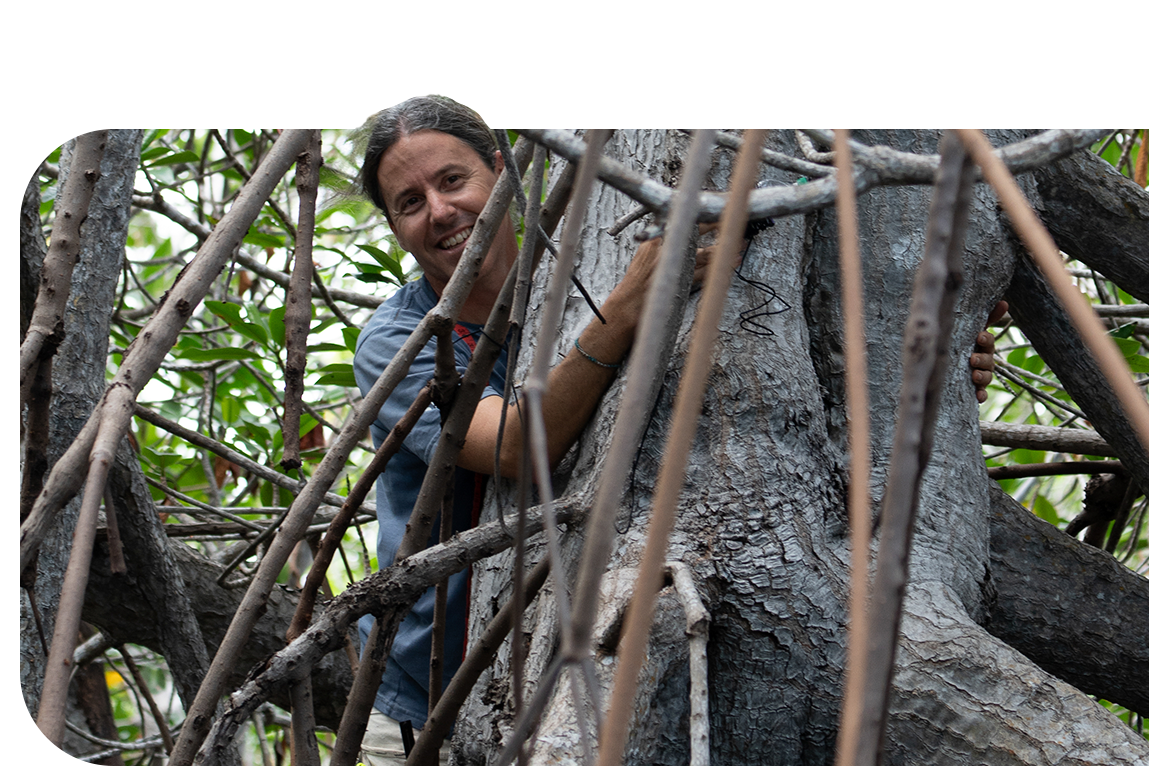
BIBLIOGRAPHY
Castrejón, M., Moity, N., & Charles, A. (2024). The bumpy road to conservation: Challenges and opportunities in updating the Galapagos zoning system. Marine Policy, 163, 106146. https://doi.org/10.1016/j.marpol.2024.106146
Ramirez, J., Moity, N., Rivera, F. E., Brandt, M., Andrade, S., Bensted-Smith, W., Domínguez, O., Espinoza, E., Grove, J. S., Keith, I., Suárez, J., Tapia, I., & Tirado-Sánchez, N. (2023). Mycteroperca olfax. The IUCN Red List of Threatened Species 2023: E.T14051A150898663. IUCN Red List of Threatened Species. https://dx.doi.org/10.2305/IUCN.UK.2023-1.RLTS.T14051A150898663.en
Ramirez, J., Moity, N., Rivera, F. E., Brandt, M., Andrade, S., Bensted-Smith, W., Domínguez, O., Espinoza, E., Grove, J. S., Keith, I., Suárez, J., Tapia, I., & Tirado-Sánchez, N. (2023). Paralabrax albomaculatus. The IUCN Red List of Threatened Species 2023: E.T183769A217448475. IUCN Red List of Threatened Species. https://dx.doi.org/10.2305/IUCN.UK.2023-1.RLTS.T183769A217448475.en
Pontón-Cevallos, J., Ramírez-Valarezo, N., Pozo-Cajas, M., Rodríguez-Jácome, G., Navarrete-Forero, G., Moity, N., Villa-Cox, G., Ramírez-González, J., Barragán-Paladines, M. J., Bermúdez-Monsalve, J. R., & Goethals, P. L. M. (2022). Fishers’ Local Ecological Knowledge to Support Mangrove Research in the Galapagos. Frontiers in Marine Science, 9. https://www.frontiersin.org/article/10.3389/fmars.2022.911109
Bates, A. E., Primack, R. B., Biggar, B. S., Bird, T. J., Clinton, M. E., Command, R. J., Richards, C., Shellard, M., Geraldi, N. R., Vergara, V., Acevedo-Charry, O., Colón-Piñeiro, Z., Ocampo, D., Ocampo-Peñuela, N., Sánchez-Clavijo, L. M., Adamescu, C. M., Cheval, S., Racoviceanu, T., Adams, M. D., … Duarte, C. M. (2021). Global COVID-19 lockdown highlights humans as both threats and custodians of the environment. Biological Conservation, 263, 109175. https://doi.org/10.1016/j.biocon.2021.109175
Bravo, G., Moity, N., Londoño-Cruz, E., Muller-Karger, F., Bigatti, G., Klein, E., Choi, F., Parmalee, L., Helmuth, B., & Montes, E. (2021). Robots Versus Humans: Automated Annotation Accurately Quantifies Essential Ocean Variables of Rocky Intertidal Functional Groups and Habitat State. Frontiers in Marine Science, 8, 1366. https://doi.org/10.3389/fmars.2021.691313
Montes, E., Lefcheck, J., Guerra Castro, E., Klein, E., de Azevedo Mazzuco, A. C., Bigatti, G., Cordeiro, C., Simoes, N., Macaya, E., Moity, N., Londoño-Cruz, E., Helmuth, B., Choi, F., Soto, E., Miloslavich, P., & Muller-Karger, F. (2021). Optimizing Large-Scale Biodiversity Sampling Effort: Toward an Unbalanced Survey Design. Oceanography, 34(2). https://doi.org/10.5670/oceanog.2021.216
Moity, N., Delgado, B., & Salinas-de-León, P. (2019). Mangroves in the Galapagos islands: Distribution and dynamics. PLOS ONE, 14(1), e0209313. https://doi.org/10.1371/journal.pone.0209313
Tanner, M. K., Moity, N., Costa, M. T., Marin Jarrin, J. R., Aburto-Oropeza, O., & Salinas-de-León, P. (2019). Mangroves in the Galapagos: Ecosystem services and their valuation. Ecological Economics, 160, 12–24. https://doi.org/10.1016/j.ecolecon.2019.01.024
Moity, N. (2018). Evaluation of No-Take Zones in the Galapagos Marine Reserve, Zoning Plan 2000. Frontiers in Marine Science, 5, 244. https://doi.org/10.3389/fmars.2018.00244

Protect Galapagos, Impact the World
The impact you make on this small ecosystem of enormous biodiversity is part of a larger footprint you are leaving for the world's future. Join us on our mission to safeguard one of our planet’s most important natural treasures through science and conservation action by making a donation today. Thank you for making an impact with us.




